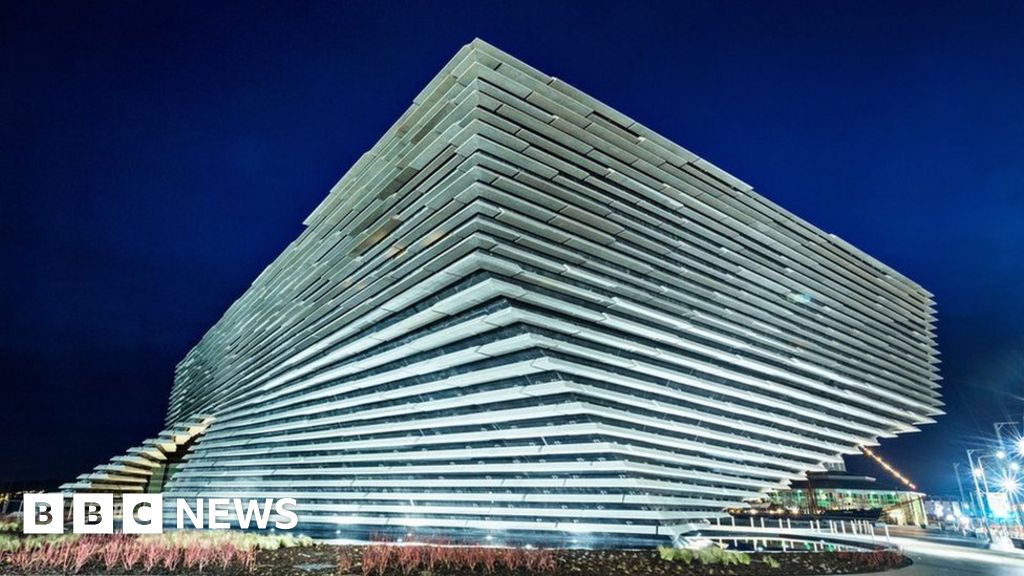Entertainment
Review: V&A Dundee ★★★★★ – BBC News

- By Will Gompertz
- Arts editor
Sitting opposite me on the train to Dundee was a 30-something woman and her son. As we crossed the Tay Rail Bridge she turned to her child and said wistfully, “it’s great to be going back to Dundee”.
He looked up at her wise face, blinked once or twice, and said, “No it’s not. It’s rubbish”.
A lively conversation then ensued between the two who traded pros and cons about Scotland’s fourth-largest city, before the mother finally brought matters emphatically to a close by saying, “You’ve never been to Maidstone!”
A bit random, I thought. And unnecessary. There is no need for put downs of Kentish towns.
Dundee has a new star attraction that should win over even the most entrenched naysayers.
Admittedly, it cost £80.1m, looks like a crushed municipal car park, and is framed by some of the ugliest modern buildings I’ve ever seen. And yet – and despite years of difficulties and political turmoil – the V&A Dundee is terrific.
Image source, V&A /Chris Wilson
I’ll go further, it is world class.
The first purpose-built design museum in Scotland is itself an instant design classic
Nothing is perfect, but small niggles aside (the triangular walkway under the building creates a hurricane-effect wind-tunnel), Kengo Kuma’s building is close to being impeccable.
From its concrete-clad, craggy cliff-face of an exterior that juts out into the Tay estuary like the prow of a ship, to the wood-panelled atrium that gives visitors the warmest of welcomes – it is a showcase of design at its best.
Image source, V&A/Hufton+Crow
Quite why the Japanese architect has never made a building in the UK before is baffling.
He is a master of his craft, working without the pomp and ego of some of his fellow so-called “starchitects” whose attention-grabbing projects aim to dominate their landscape.
It is as restrained as a royal footman: modest, sympathetic, and respectful of its surroundings.
Its relatively small scale and simple navigation reflect an attitude that seems to pervade the entire project, which is to connect visitors with design excellence in all its forms, by removing as many obstacles as possible.
Hence a two-storey building with a single staircase (or a lift if you prefer) that leads to the museum’s two well-proportioned galleries. One will host temporary exhibitions, the other the story of Scottish design.
Image source, V&A Museum/Hufton+Crow
The opening show is Ocean Liners, which recently closed at the V&A in London (about a third of the new museum’s shows will come from the Mothership in South Kensington).
The exhibition was good down south but, frankly, looks a whole load better in Dundee, which says something about the quality of the new flexible spaces Mr Kuma has created.
Image source, Michael McGurk/V&A Dundee
The Galleries of Scottish Design are also a success.
Partly because the objects are allowed to speak for themselves without overbearing visual effects or walls clogged up with impenetrable “interpretation” panels.
But also due to the content, which is well displayed and broad in range, genre, and period.
Image source, Vivienne Westwood/V&A
Vivienne Westwood’s Harris Tweed tartan jacket, Alexander McQueen’s gothic wedding dress, and a 500-year old Book of Hours all perform the role of warm-up act for the star exhibit: Charles Rennie Mackintosh’s Oak Room (1907).
It was originally built for Miss Cranston’s Tearoom in Glasgow before being salvaged by enthusiasts in the 1970s, who removed it piece by piece after the building in which it was housed was sold off to a hotel developer.
For the past 50 years it has been stored, oak plank-upon-oak plank, in a warehouse while waiting for an opportunity to re-enter the public domain, which it now has at the V&A Dundee.
Image source, V&A/Hufton+Crow
It feels a bit bare without any tables or chairs, but is still a splendid sight to behold, and is given added poignancy by the recent fire at the Glasgow School of Art, which destroyed important examples of Mackintosh architecture and interiors.
Should you tire of man-made creations, there are windows a-plenty on the first floor, from which you can enjoy the magnificent River Tay, a constant silvery presence, reflecting light back into the main hall and restaurant.
Image source, V&A/Hufton Crow
That’s to the south. Fortunately, you don’t get to see what’s going on just over the road to the north. But you will when you go outside. And with your sensibilities at their most aesthetically tuned after an hour or so in the museum you will be appalled by what confronts you.
The new railway station-hotel combo is ghastly.
As is the crass looking rectangular block being built to its side. There are, I am told, plans for more of the same in a £1bn regeneration of Dundee’s Waterfront.
Oh dear. What a shame. What a missed opportunity.
Was there not a design tsar in place to oversee the city’s regeneration masterplan? If not, why not? If there is one, what is he or she thinking?
Image source, V&A/Rapid Visual Media
The new museum was always intended as the “jewel in the crown”, but that’s no reason to decorate the rest of it with tacky add-ons.
Dundee had the foresight to invite a very good architect to build his first project in the UK on its waterfront.
Why not extend the invitation and ask him to oversee a coherent design for the entire area before it’s too late, and his wonderful new building is rendered invisible by cheap-and-cheerless eyesores.





